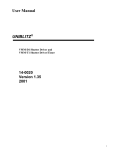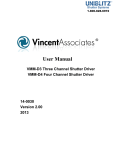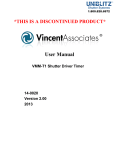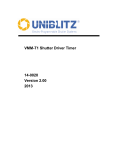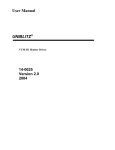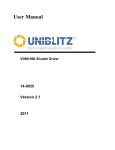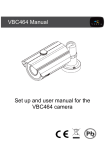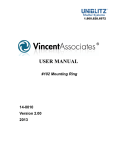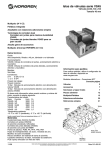Download User Manual UNIBLITZ
Transcript
User Manual
UNIBLITZ
VMM-D3 Three Channel Shutter Driver and
VMM-D4 Four Channel Shutter Driver
14-0030
Version 1.1
2003
Vincent Associates products are covered by U.S. patents.
Information in this publication supercedes that in all previously published material. Due
to our ongoing development program, Vincent Associates reserves to right to discontinue
or change specifications or designs, at any time, without incurring any obligation.
Printed in the U.S.A.
Ver. 1.1 2003
Vincent Associates, a Division of VA, Inc., 803 Linden Ave., Rochester, NY 14625
Tel: 585-385-5930 Fax: 585-385-6004
UNIBLITZ is a registered trademark of VA, Inc.
2
WARRANTY
Great care has been taken to ensure that our products are free from
defect when shipped. Defective units will be replaced or repaired
at no charge, excepting transportation charges, if returned within
one year from the date of original shipment. This offer does not
apply to burned out actuator coils and/or blown fuses.
Vincent Associates will consider the return of unused equipment if
returned within 30 days from the date of shipment, subject to a
20% restocking charge. This offer does not apply to used or
damaged equipment.
This warranty extends only to the original purchaser and is not
available to any third party, including any purchaser assemblies,
or other products of which the goods may become component
equipment.
3
Following is the complete operators manual for the UNIBLITZ VMM-D3
and VMM-D4. Please read this manual completely before operating your
unit. Due to the construction of these units, we recommend that they be
returned to the manufacturer for repair, no user serviceable parts inside.
4
General Safety Summary
Review the following safety precautions to avoid injury and prevent damage to
this product or any products connected to it. To avoid potential hazards, use the
product only as specified.
Only qualified personnel should perform service procedures.
Injury Precautions
•
Use proper Power Cord – To avoid fire hazard, use only the power cord supplied
with this product.
•
Avoid Electric Overload – To avoid electrical shock or fire hazard, do not apply a
voltage to a terminal that is outside the range specified for that terminal.
•
Avoid Electric Shock – To avoid injury or loss of life, do not connect or disconnect
line cord while it is connected to the line voltage.
•
Ground the Product – This product is grounded through the grounding conductor of
the power cord. To avoid electrical shock, the grounding connector must be
connected to earth ground. Before making connections to the input or output
terminals of the product, ensure that the product is properly grounded. DO NOT
DEFEAT THE GROUND CONNECTION ON THE SUPPLIED LINE CORD.
•
Do Not Operate Without Covers – To avoid electric shock or fire hazard, do not
operate this product with case or panels removed.
•
Use Proper Fuse – To avoid fire hazard, use only the fuse type and rating specified
for this product.
•
Do Not operate in Wet/Damp Conditions – To avoid electric shock, do not operate
this product in wet or damp conditions.
•
Do Not Operate in an Explosive Atmosphere – To avoid injury or fire hazard, do
not operate this product in an explosive atmosphere.
Product Damage Precautions
•
Use Proper Power Source – Do not operate this product from a power source that
applies more than the voltage specified.
•
Provide Proper Ventilation – To prevent product overheating, provide proper
ventilation.
Do Not Operate with Suspected Failures – If you suspect there is damage to this
product, have it inspected by qualified service personnel.
•
5
Start Up
After unpacking your unit inspect for any defects. If upon
inspection a problem is found, or a part (or parts) are missing, notify
Vincent Associates immediately.
After the initial inspection the unit is ready to use. To properly
install and power on the VMM-D3 or VMM-D4, perform this procedure.
1. Check that you have the proper electrical connections. The rear label,
which covers the AC input module, is there to remind you to manually
configure the AC input module if the unit requires operation at
230VAC. See “Voltage Change” instructions. THIS LABEL
MUST BE REMOVED PRIOR TO INSERTING THE POWER
CORD INTO THE AC INPUT CONNECTOR REGARDLESS
OF WHICH AC VOLTAGE LEVEL IS USED.
2. Check the line fuses to be sure they are the proper rating. The VMMD3 and VMM-D4 have been shipped with the proper fuses for
115VAC operation (3AG .5A time-lag). For 230VAC operation,
change line fuses to the 5mm x 20mm .25A time-lag (supplied w/unit,
packaged separately). See “Line Fuse Replacement” instructions.
3. Be sure the AC module power switch is toggled to the “0” position and
the power end of the line cord is not connected to the AC line. Then
connect the opposite end of the supplied line cord to the rear panel AC
module connector. Be sure the cord is inserted completely into the AC
module connector.
4. Connect the power end of the line cord to the AC line. Power unit ON
by toggling the AC module power switch to the “1” position. Power
LED indicator will illuminate.
Line Fuse Replacement
WARNING. To avoid injury or death, unplug the line cord from the
line voltage power source before continuing.
1. Have handy a small flat-bladed screwdriver or similar tool and refer to
Figure #1.
2. Set the VMM-D3 or VMM-D4 unit so that the rear panel is facing you.
3. BE SURE THE LINE CORD IS DISCONNECTED FROM THE
LINE VOLTAGE POWER SOURCE. Unplug the line cord from
the AC module connector. You cannot proceed with this procedure
without removing the line cord from the VMM-D3/D4 control unit.
6
4. Using the small flat bladed screwdriver or similar tool; insert the tool
into the cover door slot; pry open cover door.
5. Using the same tool; insert the tool into the fuse holder slot; pry out
the fuse holder block.
6. Remove defective fuse(s); replace with new fuse(s) and replace fuse
holder into housing; close the cover door.
Voltage Change
WARNING. To avoid injury or death, unplug the line cord from the
line voltage power source before continuing.
1. Repeat steps 1-5 in “Line Fuse Replacement” instructions and refer
to Figure #1.
2. Rotate the fuse holder block 180°; if changing to 230VAC, replace fuses
with two 5mm x 20mm .25A time-lag fuses. (Be sure to change fuses
back to 3AG .5A time-lag fuses when changing back to 115VAC).
3. Replace fuse holder block and close the cover door. The desired
voltage will be indicated and appear in the cover door window.
Figure #1 - AC Input Module
7
VMM-D3/D4 Three/Four Channel
Shutter Driver Description
1. General:
a) Three-channel shutter driver capable of driving up to three Vincent
shutters independently. (Four channel – VMM-D4)
b) Three independent inputs to allow individual shutter control. (Four
inputs – VMM-D4)
c) One input to open all shutters simultaneously.
d) Three independent outputs to monitor the individual synchronization
outputs of each shutter. (Four outputs – VMM-D4)
e) One output to monitor when all individual synchronization outputs
are active.
f) Manual open/close switch for each channel. Allows inverse shutter
operation.
g) Energy select slide switch (HI/LO) at rear panel for each channel to allow VS35
(35 mm aperture), CS45, and VS45 (45 mm aperture) shutter operation.
2. Indicator LEDs:
a) One red LED to monitor the status of each drive input.
b) One green LED to monitor the status of each synchronization output.
c) One indicator to indicate power on condition.
3. Control switches:
a) Open/Close (N.O/N.C.) switch for each channel located at the front panel –
allows manual opening of each individual shutter. In the Normally Open (N.O.)
position, active trigger inputs will close shutter – inverse operation.
b) Energy select (HI/LO) switches for each channel located at the rear panel – allows
selection of additional pulse energy necessary when operating larger aperture
shutters, the VS35, CS45 and the VS45.
c) Address select (SW1) switch (VMM-D3 only) located at the front panel – used in
conjunction with the RS-232C input to select specific address for the unit when
using a daisy chain application. (See Figure #3 Daisy Chain Cable Configuration)
4. Dimensional requirement:
a) Same size as the UNIBLITZ VMM-D1 control unit (HWD) – 2.6 x 5.5 x 8.0 in
(6.6 x 13.9 x 20.3 cm).
5. Connectors:
a) Two six conductor pluggable terminal strips. One for inputs and one for outputs.
i)
INPUT CONTROL (5VTTL logic):
(1) Pin #1 – Active High, Shutter #1, High – open, low – closed.
(2) Pin #2 – Active High, Shutter #2, High – open, low – closed.
(3) Pin #3 – Active High, Shutter #3, High – open, low – closed.
(4) Pin #4 – Active High, Shutter #4, High – open, low – closed. (Not active
on VMM-D3.)
(5) Pin #5 – Active High, Shutter #1-#4 (#1-#3 – VMM-D3), High – open,
low – closed.
(6) Pin #6 – Signal ground.
8
ii)
OUTPUT CONTROL (5VTTL logic): {Tie unused channel output to
ground to utilize “All Synchronization Signals”}
(1) Pin #1 – Active Low, Shutter #1, Low – open, high – closed.
(2) Pin #2 – Active Low, Shutter #2, Low – open, high – closed.
(3) Pin #3 – Active Low, Shutter #3, Low – open, high – closed.
(4) Pin #4 – Active Low, Shutter #4, Low – open, high – closed. (Not active
on VMM-D3.)
(5) Pin #5 – Active Low, Shutter #1-#4 (#1-#3 – VMM-D3), All
Synchronization signals active, Low – all open, High – all closed.
(6) Pin #6 – Signal ground.
b) Four 7-pin shutter connectors, one per shutter. (Channel #4 disabled - VMM-D3)
Pin out as follows:
i)
Pin A – Shutter send
ii)
Pin B – Shutter return
iii)
Pin C – Sync. diode source
iv)
Pin D – Sync. diode return
v)
Pin E – Sync. transistor input
vi)
Pin F – Sync. - +6.75 VDC source
vii)
Pin H – Shutter ground
c) One standard 710C 10ft. shutter interconnect cable included for each active
channel.
d) DB-9 Female, RS-232C connection (VMM-D3 only). Pin out as follows:
Function
i)
Pin 2 Rx
Receive Data
ii)
Pin 3 Tx
Transmit Data
iii)
Pin 5 GND Signal Ground
iv)
Pin 6 DSR Data Set Ready
v)
Pin 7 RTS
Request to Send
vi)
Pin 8 CTS
Clear to Send
vii)
Commands and Specifications for RS-232C input:
RS-232C (DB-9 female) Baud rate 9600, 8 Data bits, 1 Stop bit, No parity,
No flow control; 8 commands available; 1
global, 8 local address locations for commands
(see "ADDRESS Select" specification for switch
settings of local address locations).
RS232
Commands
Open Ch. #1
Close Ch.#1
Open Ch. #2
Close Ch.#2
Open Ch. #3
Close Ch.#3
All Open
All Close
Global Address Codes
Decimal HEX Octal
Binary
ASCII
64
40
100
01000000 @
65
41
101
01000001 A
66
42
102
01000010 B
67
43
103
01000011 C
68
44
104
01000100 D
69
45
105
01000101 E
70
46
106
01000110 F
71
47
107
01000111 G
9
ADDRESS Select Allows selection of individual (local) address locations of
(SW1)
commands sent by a PC's serial port.
RS232
Commands
Open Ch. #1
Close Ch.#1
Open Ch. #2
Close Ch.#2
Open Ch. #3
Close Ch.#3
All Open
All Close
viii)
ADDRESS Switch Positions (x = don't care or global)
x
0
1
2
3
4
5
6
7
40 80 90 A0 B0 C0 D0 E0 F0 (Hex)
41 81 91 A1 B1 C1 D1 E1 F1 (Hex)
42 82 92 A2 B2 C2 D2 E2 F2 (Hex)
43 83 93 A3 B3 C3 D3 E3 F3 (Hex)
44 84 94 A4 B4 C4 D4 E4 F4 (Hex)
45 85 95 A5 B5 C5 D5 E5 F5 (Hex)
46 86 96 A6 B6 C6 D6 E6 F6 (Hex)
47 87 97 A7 B7 C7 D7 E7 F7 (Hex)
RS-232 Test Program for the VMM-D3
REM PROGRAM TO SEND COMMAND PULSES TO VMM-D3 RS232 INTERFACE, XILINX CPLD.
REM WRITTEN BY RICHARD ST.LOUIS, VINCENT ASSOCIATES.
REM LAST REVISION 8/2/99.
CLS 0
K = -1
WHILE K
OPEN "COM1:9600,N,8,1,CS0,DS0" FOR RANDOM AS #1
J = 64
C$ = "X"
MENU:
PRINT
PRINT
PRINT
PRINT "WAITING FOR KEYSTROKE COMMAND "
PRINT "TYPE:"
PRINT "
VMM-D3
"
PRINT "
-----"
PRINT " O - OPEN Ch. 1
"
PRINT " C - CLOSE Ch. 1
"
PRINT " P - OPEN Ch. 2
"
PRINT " L - CLOSE Ch. 2
"
PRINT " N - OPEN Ch. 3
"
PRINT " E - CLOSE Ch. 3
"
PRINT " A - ALL Ch.'s OPEN "
PRINT " R - ALL Ch.'s CLOSE "
PRINT
PRINT " S - SET Octal Switch Address "
PRINT "
(Current Starting Decimal # ="; J; ")"
PRINT "
(Current Octal Address Value = "; C$; ")"
PRINT
PRINT " Q - QUIT Program
"
10
PRINT
PRINT
START: A$ = INKEY$
IF A$ = "O" OR A$ = "o" THEN
PRINT #1, CHR$(J);
PRINT "Ch. 1 OPEN COMMAND SENT"
GOSUB TIMEOUT
GOTO MENU
ELSEIF A$ = "C" OR A$ = "c" THEN
PRINT #1, CHR$(J + 1);
PRINT "Ch. 1 CLOSE COMMAND SENT"
GOSUB TIMEOUT
GOTO MENU
ELSEIF A$ = "P" OR A$ = "p" THEN
PRINT #1, CHR$(J + 2);
PRINT "Ch. 2 OPEN COMMAND SENT"
GOSUB TIMEOUT
GOTO MENU
ELSEIF A$ = "L" OR A$ = "l" THEN
PRINT #1, CHR$(J + 3);
PRINT "Ch. 2 CLOSE COMMAND SENT"
GOSUB TIMEOUT
GOTO MENU
ELSEIF A$ = "N" OR A$ = "n" THEN
PRINT #1, CHR$(J + 4);
PRINT "Ch. 3 OPEN COMMAND SENT"
GOSUB TIMEOUT
GOTO MENU
ELSEIF A$ = "E" OR A$ = "e" THEN
PRINT #1, CHR$(J + 5);
PRINT "Ch. 3 CLOSE COMMAND SENT"
GOSUB TIMEOUT
GOTO MENU
ELSEIF A$ = "A" OR A$ = "a" THEN
PRINT #1, CHR$(J + 6);
PRINT "ALL Ch.'s OPEN COMMAND SENT"
GOSUB TIMEOUT
GOTO MENU
ELSEIF A$ = "R" OR A$ = "r" THEN
PRINT #1, CHR$(J + 7);
PRINT "ALL Ch.'s CLOSE COMMAND SENT"
GOSUB TIMEOUT
GOTO MENU
ELSEIF A$ = "Q" OR A$ = "q" THEN
K=0
PRINT "PROGRAM TERMINATED"
ELSEIF A$ = "S" OR A$ = "s" THEN
INPUT "ENTER OCTAL ADDRESS 0 - 7 or X: ", B$
GOSUB ADDRESS
GOTO MENU
ELSE GOTO START
END IF
WEND
END
11
TIMEOUT:
ADDRESS:
FOR I = 1 TO 100: NEXT I
CLS 0
RETURN
IF B$ = "X" OR B$ = "x" THEN
J = 64
C$ = "X"
ELSEIF B$ = "0" THEN
J = 128
C$ = "0"
ELSEIF B$ = "1" THEN
J = 144
C$ = "1"
ELSEIF B$ = "2" THEN
J = 160
C$ = "2"
ELSEIF B$ = "3" THEN
J = 176
C$ = "3"
ELSEIF B$ = "4" THEN
J = 192
C$ = "4"
ELSEIF B$ = "5" THEN
J = 208
C$ = "5"
ELSEIF B$ = "6" THEN
J = 224
C$ = "6"
ELSEIF B$ = "7" THEN
J = 240
C$ = "7"
ELSE J = 64
C$ = "X"
END IF
PRINT "STARTING ASCII DECIMAL # = ", J
GOSUB TIMEOUT
CLS 0
RETURN
6. Panel control, indicator, switch, and connector locations:
a) Front panel:
i)
Open/Close switches (three – VMM-D3, four – VMM-D4).
ii)
Shutter drive LED indicators (three – VMM-D3, four – VMM-D4).
iii)
Synchronization status LED indicators (three – VMM-D3, four – VMM-D4).
iv)
Fuse holder with .600A slow blow fuse (three – VMM-D3, four – VMM-D4).
v)
DB-9 female connector for RS-232 interface (VMM-D3 only).
vi)
SW1 address select switch used with RS-232 interface to select unique
address (VMM-D3 only).
b) Rear Panel:
i)
Four 7-pin shutter connectors (Channel #4 not active on the VMM-D3)
ii)
Four energy select (HI/LO) slide switches (Channel #4 not active on the
VMM-D3)
iii)
Two, six conductor pluggable terminal strips.
12
iv)
One, 3-pin IEC type power connector with two .500A slow blow fuses, 3A
line filter, power switch, and 115/230VAC switching block.
7. Power input:
a) 115VAC 60Hz./230VAC 50Hz. – three prong North American Power cord with IEC
type connector for input at unit, included.
8. Daisy Chain Configuration:
a) Up to eight VMM-D3 units can be daisy chained together (connected through the
same serial port) using the 910RSDC cable. In this way 24 shutters can be
controlled from on computer COM (serial) port. One of these daisy chain cables
is required for each controller in the chain. See Figure #3. Figure #3 illustrates
connecting two controllers from a single serial port. Once connected, each unit
will require a unique address in the chain. This is accomplished by adjusting the
octal switch labeled (SW1) located beneath the 9-Pin D-sub connector on the
front panel to the desired command range. (See “ADDRESS Select” in section
5.d. for a complete listing of the command range for each octal switch position.)
The specific command range sent will decode commands sent via the serial port.
A set of “ALL” commands is also available to control all units connected to the
serial port. For a single unit not requiring a Daisy Chain Configuration a 910RS
cable can be used.
9. Drawings attached:
a) See attached drawings L-0203 (VMM-D3, Figure #1) and L-0244 (VMM-D4, Figure
#2) for overall size and indicator, control, and connector locations.
b) See VMM-D3, Figure #3 for Daisy Chain Cable Configuration.
13
SPECIFICATIONS
SYSTEM CHARACTERISTICS
Description
VMM-D3 VMM-D4 Name
*
*
Repeat Exposure
35 mS minimum between exposures (100 mS minimum for VS35,
CS45, and VS45 shutters).
*
*
Shutter Drive
Continuously variable frequency of exposures from DC to the
shutter's maximum rate; maximum peak pulse power 400 W,
pulse voltage 70 VDC, pulse current 5.7 A (test conditions:
standard 5 Volt, 12 ohm coil cycled with 20 mS exposure at 5 Hz).
*
*
Repetition Rate
Maximum repetition rate determined by applicable shutter;
maximum rate derated by 75% when more than one shutter
channel is used.
EXTERNAL INPUT CHARACTERISTICS
Description
VMM-D3 VMM-D4 Name
*
*
Ch. #1 Pulse In
(INPUT CONTROL Pin 1)
*
*
Ch. #2 Pulse In
(INPUT CONTROL Pin 2)
*
*
Ch. #3 Pulse In
(INPUT CONTROL Pin 3)
*
Ch. #4 Pulse In
(INPUT CONTROL Pin 4)
Active-high only; input impedance 4.7K ohms; minimum pulse
width determined by applicable shutter; maximum pulse width
unlimited; TTL compatible: minimum high-level +2.0 VDC,
maximum low-level +0.8 VDC; sink current 1µA. Located on rear
panel.
Active-high only; input impedance 4.7K ohms; minimum pulse
width determined by applicable shutter; maximum pulse width
unlimited; TTL compatible: minimum high-level +2.0 VDC,
maximum low-level +0.8 VDC; sink current 1µA. Located on rear
panel.
Active-high only; input impedance 4.7K ohms; minimum pulse
width determined by applicable shutter; maximum pulse width
unlimited; TTL compatible: minimum high-level +2.0 VDC,
maximum low-level +0.8 VDC; sink current 1µA. Located on rear
panel.
Active-high only; input impedance 4.7K ohms; minimum pulse
width determined by applicable shutter; maximum pulse width
unlimited; TTL compatible: minimum high-level +2.0 VDC,
maximum low-level +0.8 VDC; sink current 1µA. Located on rear
panel.
14
EXTERNAL INPUT CHARACTERISTICS (cont.)
Description
VMM-D3 VMM-D4 Name
*
*
All Ch.'s Pulse In
(INPUT CONTROL Pin 5)
*
*
Signal Ground Input
(INPUT CONTROL Pin 6)
*
RS-232C (DB-9 female)
Active-high only; input impedance 4.7K ohms; minimum pulse
width determined by applicable shutter; maximum pulse width
unlimited; TTL compatible: minimum high-level +2.0 VDC,
maximum low-level +0.8 VDC; sink current 1µA. Located on rear
panel.
0 VDC ground reference provided for INPUT CONTROL trigger
signal pins 1 through 5. Located on rear panel.
Baud rate 9600, 8 Data bits, 1 Stop bit, No parity, No flow control;
8 commands available; 1 global, 8 local address locations for
commands (see SW1 specification for switch settings of local
address locations). Located on front panel.
RS232
Global Address Code Locations
Commands Decimal HEX Octal
Binary
ASCII
Open Ch. #1
64
40
100
01000000 @
Close Ch. #1
65
41
101
01000001 A
Open Ch. #2
66
42
102
01000010 B
Close Ch. #2
67
43
103
01000011 C
Open Ch. #3
68
44
104
01000100 D
*
*
*
*
*
*
*
*
Close Ch. #3
All Open
All Close
69
70
71
45
46
47
105
106
107
01000101
01000110
01000111
E
F
G
EXTERNAL OUTPUT CHARACTERISTICS
Description
VMM-D3 VMM-D4 Name
*
*
Ch. #1 SYNC. Output
(OUTPUT CONTROL Pin
1)
Active-low only; source impedance 1K ohms; maximum source
current 6.75 mA; maximum sink current 25 mA; maximum (lowlevel) output voltage +0.25 VDC. This output provided for shutter
equipped with Electronic Sync. option. Located on rear panel.
*
*
Ch. #2 SYNC. Output
(OUTPUT CONTROL Pin
2)
Active-low only; source impedance 1K ohms; maximum source
current 6.75 mA; maximum sink current 25 mA; maximum (lowlevel) output voltage +0.25 VDC. This output provided for shutter
equipped with Electronic Sync. option. Located on rear panel.
*
*
Ch. #3 SYNC. Output
(OUTPUT CONTROL Pin
3)
Active-low only; source impedance 1K ohms; maximum source
current 6.75 mA; maximum sink current 25 mA; maximum (lowlevel) output voltage +0.25 VDC. This output provided for shutter
equipped with Electronic Sync. option. Located on rear panel.
15
EXTERNAL OUTPUT CHARACTERISTICS (cont.)
Description
VMM-D3 VMM-D4 Name
*
Ch. #4 SYNC. Output
(OUTPUT CONTROL Pin
4)
Active-low only; source impedance 1K ohms; maximum source
current 6.75 mA; maximum sink current 25 mA; maximum (lowlevel) output voltage +0.25 VDC. This output provided for shutter
equipped with Electronic Sync. option. Located on rear panel.
*
*
All Ch.'s SYNC. Output
(OUTPUT CONTROL Pin
5)
Active-low only; source impedance 10K ohms; maximum source
current 500 µA; maximum sink current 4 mA; maximum (lowlevel) output voltage +0.4 VDC. This output provided for shutter
equipped with Electronic Sync. option. Located on rear panel.
*
*
SYNC. Ground Output
(OUTPUT CONTROL Pin
6)
0 VDC ground reference provided for OUTPUT CONTROL Sync.
pins 1 through 5. Located on rear panel.
GENERAL CHARACTERISTICS
Description
VMM-D3 VMM-D4 Name
*
*
POWER Indicator
*
*
DRIVER ACTIVE Indicator Red 3mm LED indicates when each shutter driver circuit is active.
This LED will illuminate with or without the load of a shutter's
actuator coil. Located on front panel.
*
*
SYNC. ACTIVE Indicator
Green 3mm LED indicates when each shutter's opto-electronic
Synchronous circuit option is active. SYNC. OUTPUT will be low
only when this LED is illuminated. Located on front panel.
SW1 Address Select
Allows selection of individual (local) address locations of
commands sent by a computer's serial port (see page 10 for test
program). Located on front panel.
*
*
*
*
*
*
*
*
*
Red 3mm LED indicates when power is available. Located on
front panel, lower right-hand corner.
RS232 ADDRESS Switch Locations (x = don't care or global)
Commands x
0 1
2
3
4
5
6
7
Open Ch. #1 40 80 90 A0 B0 C0 D0 E0 F0 (HEX)
Close Ch. #1 41 81 91 A1 B1 C1 D1 E1 F1 (HEX)
Open Ch. #2 42 82 92 A2 B2 C2 D2 E2 F2 (HEX)
Close Ch. #2 43 83 93 A3 B3 C3 D3 E3 F3 (HEX)
Open Ch. #3 44 84 94 A4 B4 C4 D4 E4 F4 (HEX)
Close Ch. #3
All Open
All Close
45
46
47
85
86
87
95
96
97
16
A5
A6
A7
B5
B6
B7
C5
C6
C7
D5
D6
D7
E5
E6
E7
F5
F5
F7
(HEX)
(HEX)
(HEX)
GENERAL CHARACTERISTICS (cont.)
Description
VMM-D3 VMM-D4 Name
*
*
HI/LOW Energy Select
Slide-switch HI/LOW allows the selection of additional pulse
energy for the VS35, CS45, VS45, and CS65 shutter ("HI"
position). Located on rear panel underneath each respective 7-pin
shutter connector.
*
*
Power Requirements
115 VAC ±5%, 60 Hz or 230 VAC ±10%, 50 Hz. Selected
manually by rotating the fuse-holder of the AC power entry module
(located on rear panel). See "Voltage Change" instructions.
*
*
*
*
*
*
Fuse Requirements
two ½ Amp slow blow (¼ x 1¼") for 115 VAC line
two ¼ Amp slow blow (5 x 20mm) for 230 VAC line
one 0.6 Amp slow blow (5 x 20mm) for each Shutter coil
See "Voltage Change" instructions for AC power fuse change.
*
*
Operating Temperature
0° to 50° C (32° to 122° F)
*
*
Storage Temperature
-20° to 55° C (-4° to 131° F)
*
*
Size (HWD)
2.638" x 5.354" x 8.186" (67.0 x 136.0 x 207.9 mm)
Weight
4.45 lbs (2.02 kg)
4.55 lbs (2.06 kg)
Accessories (supplied)
710C shutter interconnect cable (1 each per channel)
AC line cord
230 VAC line fuses (two ¼ Amp Slo-Blo fuses, 5 x 20mm)
User Manual
Optional Accessories
910RS RS-232C interconnect serial cable
910RSDC RS-232C Daisy Chain interconnect serial cable
7M/4F shutter-adapter cable
*
*
*
*
*
*
*
*
*
*
*
*
*
*
17
Figure #1 VMM-D3 Panel Layout
18
Figure #2 VMM-D4 Panel Layout
19
SHUTTER DRIVER
REE CH
Figure #3 VMM-D3 Daisy Chain Cable Configuration
20
NOTES
21





















